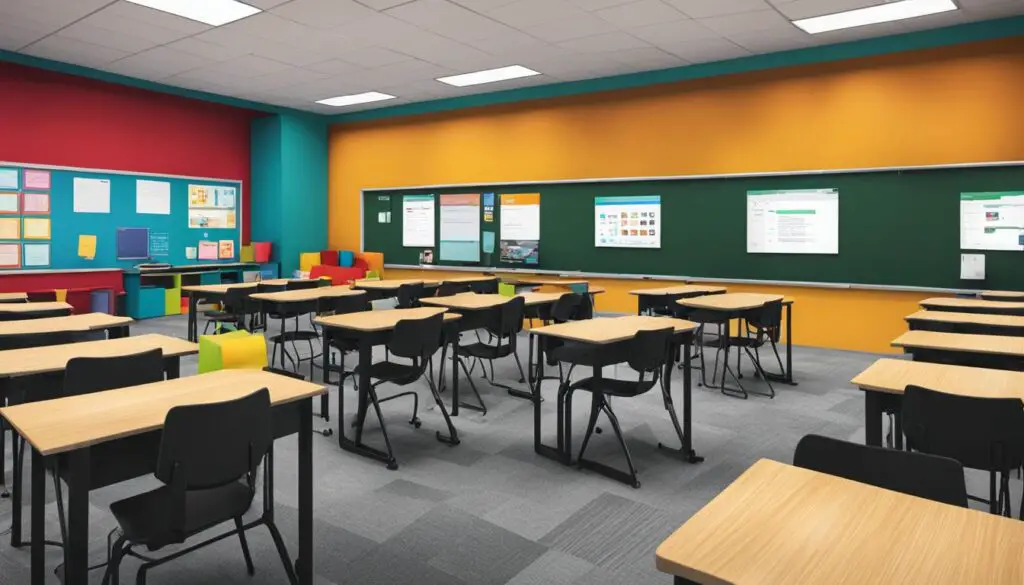A school improvement plan is a vital tool for schools aiming to progress student achievement and overall operations. One effective approach to setting goals in the plan is through SMART goals, which are Specific, Measurable, Achievable, Relevant, and Time-bound. These goals cover a wide range of focus areas, including student achievement, learning environment, equity, technology, and more. By implementing these goals, schools can create a roadmap for success and drive meaningful change.
Key Takeaways:
- SMART goals are an effective approach to setting goals in a school improvement plan.
- SMART goals for teachers are Specific, Measurable, Achievable, Relevant, and Time-bound.
- Implementing comprehensive SMART goals can drive meaningful change in schools.
- SMART behavior goals can be applied to various focus areas, such as student achievement, learning environment, equity, and technology.
- By setting and implementing SMART goals, schools can create a roadmap for success.
The Importance of SMART Goals in Crafting Your School Improvement Plan
Setting SMART goals is crucial in crafting a school improvement plan that is effective and impactful. SMART goals provide clarity and direction by ensuring that goals are specific, measurable, achievable, relevant, and time-bound. By adhering to these criteria, schools can create goals that are clear, actionable, and aligned with the overall improvement plan.
SMART goals also allow for effective monitoring and evaluation, as progress can be easily measured against the defined criteria. By having measurable goals, schools can track their progress and make data-driven decisions to adjust their strategies if needed. This helps ensure that the improvement plan stays on track and leads to tangible results.
Another key benefit of SMART goals is that they are achievable. By setting realistic and attainable goals, schools can increase motivation and engagement among stakeholders. When goals seem feasible, the school community is more likely to work together collaboratively, pooling their efforts towards achieving the desired outcomes.
The relevance of goals is critical for their effectiveness. SMART goals help schools ensure that they are setting goals that directly align with their improvement plan and address specific areas of improvement. By focusing on relevant goals, schools can invest their time, resources, and energy into initiatives that will have the most significant impact on student achievement and overall school success.
Lastly, SMART goals are time-bound, meaning they have a specific deadline or timeframe for achievement. This adds a sense of urgency and allows for effective planning and resource allocation. By setting deadlines for goals, schools can create a roadmap that guides their actions and keeps everyone accountable.
In conclusion, SMART goals are essential in crafting a school improvement plan that is strategic, effective, and results-oriented. They provide clarity, measurability, achievability, relevance, and a sense of urgency. By setting SMART goals, schools can drive meaningful change, monitor progress, and foster a collective effort toward achieving their vision of success.
Identifying Focus Areas for Student Achievement and Learning
To drive student achievement and learning, schools must identify specific focus areas. This involves evaluating current student performance metrics, such as standardized test scores, graduation rates, and attendance records, to identify areas of improvement. By conducting a comprehensive analysis of this data, schools can identify strengths and weaknesses and target their efforts accordingly.
Once focus areas are identified, schools can then develop action plans that include the implementation of evidence-based programs and interventions. These programs and interventions should be grounded in research and proven to be effective in addressing the identified focus areas.

Evaluating Current Student Performance Metrics
Evaluating current student performance metrics is an essential step in the school improvement process. By analyzing data such as standardized test scores, graduation rates, and attendance records, schools can gain valuable insights into student performance and identify areas that need improvement. This data analysis allows schools to track progress over time, identify trends, and make informed decisions about instructional strategies and interventions.
Through data analysis, schools can identify focus areas where student achievement may be lagging. For example, if the data shows low math proficiency scores across grade levels, the school can prioritize mathematics instruction and intervention strategies to address this area of concern.
Implementing Evidence-Based Programs and Interventions
Once focus areas have been identified through data analysis, schools can then implement evidence-based programs and interventions to support student achievement and learning. These programs and interventions are grounded in research and have been proven to be effective in addressing specific learning needs.
Examples of evidence-based programs and interventions include targeted literacy interventions for struggling readers, differentiated instruction strategies to meet the diverse needs of students, and social-emotional learning programs to promote student well-being and resilience.
By implementing evidence-based programs and interventions, schools can provide students with the support they need to succeed academically and reach their full potential. These programs and interventions serve as a structured framework to guide instructional practices and ensure that schools are employing effective strategies to improve student achievement and learning outcomes.
| Focus Area | Performance Metric | Evidence-Based Program/Intervention |
|---|---|---|
| Mathematics | Low math proficiency scores | Implementation of a research-based math curriculum and targeted intervention strategies for struggling students |
| Literacy | Below grade-level reading scores | Implementation of a phonics-based reading program and small group reading instruction |
| Attendance | High rates of chronic absenteeism | Implementation of a comprehensive attendance incentive program and targeted supports for at-risk students |
| Social-Emotional Learning | Low levels of student engagement and emotional well-being | Implementation of a school-wide social-emotional learning curriculum and targeted interventions to support student well-being |
In summary, identifying focus areas for student achievement and learning involves evaluating current student performance metrics and conducting data analysis. Once focus areas are identified, schools can implement evidence-based programs and interventions that have been proven to be effective. By employing these strategies, schools can create a supportive and enriching learning environment that promotes student success and fosters continuous improvement.
6 School Improvement Goals to Foster a Supportive Learning Environment
A supportive learning environment is crucial for fostering student success and well-being. Schools can set specific improvement goals to create a positive school culture, promote student engagement, and ensure a safe and inclusive climate. These goals may include strategies to enhance behavior management practices, strengthen relationships between students and teachers, and prioritize the social-emotional development of students. Schools can create a conducive atmosphere for academic achievement and holistic student growth by setting goals to foster a supportive learning environment.
To foster a supportive learning environment, schools can focus on the following goals:
- Enhancing behavior management practices to promote a positive and respectful school climate.
- Strengthening relationships between students and teachers through increased communication and mentorship programs.
- They are prioritizing the social-emotional development of students by implementing programs and interventions that address their well-being and mental health.
- Promoting a culture of inclusivity and diversity by celebrating different backgrounds and perspectives.
- Providing resources and support for students to develop essential life skills, such as problem-solving, critical thinking, and collaboration.
- Creating a safe and welcoming physical environment that meets the needs of all students.
By focusing on these goals, schools can foster a supportive learning environment where students feel valued, engaged, and motivated to succeed. This will ultimately contribute to their overall well-being and academic achievement.

Promoting Equity and Access for Every Student
Equity and access are fundamental principles in education. Schools play a vital role in ensuring that every student has equal opportunities to succeed. To promote equity and access, schools can set improvement goals that focus on creating enrichment opportunities for diverse learning needs. This may involve designing inclusive curricula and instructional strategies that cater to the individual needs of students from various backgrounds. Additionally, schools can implement culturally responsive teaching practices to promote equity and create a more inclusive learning environment.
Creating Enrichment Opportunities for Diverse Learning Needs
Creating enrichment opportunities for diverse learning needs is essential to ensure that all students receive a high-quality education. This involves designing curriculum and instructional practices that recognize and accommodate the unique learning styles, abilities, and backgrounds of each student. By providing enrichment opportunities that address diverse learning needs, schools can foster a more inclusive and supportive learning environment.
One way schools can create enrichment opportunities is by offering differentiated instruction. This approach involves tailoring teaching methods, materials, and assessments to meet the specific needs and abilities of individual students. By providing different pathways to learning, schools can ensure that every student has the opportunity to thrive.

In addition to differentiated instruction, schools can also implement enrichment programs and activities that cater to diverse learning needs. These programs may include additional resources, support services, or specialized courses to provide students with opportunities for academic growth and exploration.
Furthermore, culturally responsive teaching is an important aspect of creating enrichment opportunities for diverse learning needs. This approach involves recognizing and valuing the cultural backgrounds, experiences, and perspectives of students. By incorporating culturally relevant content and teaching methods, schools can foster a more inclusive and engaging learning environment that celebrates diversity.
In conclusion, promoting equity and access for every student requires schools to establish improvement goals that prioritize creating enrichment opportunities for diverse learning needs. By implementing inclusive practices, offering differentiated instruction, and providing culturally responsive teaching, schools can ensure that every student has the opportunity to thrive and succeed.
Understanding the Role of Technology and Community in School Improvement
Technology and community engagement are key factors in driving school improvement and creating a network of support. When utilized effectively, technology can enhance instruction, assessment, and communication with stakeholders. In addition, community involvement plays a crucial role in fostering sustainable improvement.
Working with Organizations and Partners for Resource Support
One important aspect of school improvement is resource support. Schools can establish partnerships with organizations and community members to access valuable resources, expertise, and support. Through these collaborations, schools can expand their access to technology, educational programs, and other resources that enhance student learning and engagement.
One goal for leveraging technology and community partnerships is to integrate technology into the curriculum. By incorporating technology tools and platforms, schools can create engaging and interactive student learning experiences. This integration can involve using educational software, online resources, and multimedia materials that align with curriculum standards and enhance the student’s learning journey.
Another crucial goal is to facilitate parent involvement. Engaging parents in their child’s education can have a significant impact on student success. Schools can leverage technology to improve communication with parents, providing timely updates, sharing student progress, and involving parents in school activities. By involving parents in their child’s education, schools foster a collaborative learning environment that supports student achievement.
Establishing collaborative relationships with local organizations is also important for school improvement. Schools can partner with businesses, non-profit organizations, and local government entities to access additional resources, mentorship programs, and expert advice. These partnerships can provide unique learning opportunities for students and support the school’s overall improvement efforts.

By harnessing the power of technology and community partnerships, schools can enhance their improvement efforts and drive meaningful change. Integrating technology into the curriculum, promoting parent involvement, and forming partnerships with local organizations are essential steps in creating a supportive and engaging learning environment for every student.
9 SMART Goal Examples for School Improvement
Setting specific, measurable, achievable, relevant, and time-bound (SMART) goals is essential for driving meaningful change in school improvement. To provide practical guidance and inspiration, here are SMART goal examples that cover a wide range of focus areas.
Student Achievement and Instructional Strategies
- Specific Goal: Increase reading proficiency by 10% for all third-grade students by the end of the school year.
- Measurable Goal: Improve math test scores by an average of 15% across all grades within one academic year.
- Achievable Goal: Increase the number of Advanced Placement (AP) course offerings by at least 20% to provide more challenging opportunities for high-achieving students.
School Culture and Community Engagement
- Specific Goal: Implement a school-wide recognition program to acknowledge student achievements and promote a positive school culture.
- Measurable Goal: Increase parent participation in school events by 25% through targeted communication and outreach strategies.
- Relevant Goal: Enhance diversity and inclusion by implementing culturally responsive teaching practices and incorporating diverse perspectives into the curriculum.
Technology Integration and Innovation
- Specific Goal: Provide professional development for teachers to improve their digital literacy skills and effectively integrate technology into instructional practices.
- Measurable Goal: Increase student access to technology devices, ensuring a ratio of one device per every two students in classrooms.
- Time-bound Goal: Implement a school-wide online learning platform within the next academic year to support blended learning and remote education opportunities.
By utilizing these SMART goal examples, schools can develop action plans that align with their improvement objectives. Remember to regularly evaluate progress, adjust strategies if necessary, and celebrate achievements along the way. By setting clear and actionable goals, schools can drive positive student outcomes and overall school success.
FAQ
What is a school improvement plan?
A school improvement plan is a strategic document that outlines specific goals, objectives, and strategies to enhance student achievement and overall school operations.
What are SMART goals?
SMART goals are goals that are Specific, Measurable, Achievable, Relevant, and Time-bound, which provide clarity and direction for school improvement efforts.
Why are SMART goals important in crafting a school improvement plan?
SMART goals are important in crafting a school improvement plan because they ensure that goals are clear, actionable, and aligned with the overall plan, allowing for effective monitoring and evaluation.
How can schools identify focus areas for student achievement and learning?
Schools can identify focus areas for student achievement and learning by evaluating current student performance metrics, such as standardized test scores, graduation rates, and attendance records.
How can schools implement evidence-based programs and interventions?
Schools can implement evidence-based programs and interventions by conducting a comprehensive needs assessment, selecting programs grounded in research, and developing action plans for implementation.
How can schools foster a supportive learning environment?
Schools can foster a supportive learning environment by setting improvement goals that focus on promoting a positive school culture, student engagement, and prioritizing the social-emotional development of students.
How can schools promote equity and access?
Schools can promote equity and access by setting improvement goals that focus on creating enrichment opportunities for diverse learning needs and implementing culturally responsive teaching practices.
What is the role of technology in school improvement?
Technology plays a significant role in school improvement by enabling effective instruction, assessment, and communication with stakeholders, leading to enhanced learning experiences.
How can schools leverage community engagement?
Schools can leverage community engagement by forming partnerships with organizations and community members, facilitating parent involvement, and accessing resources, expertise, and support.
Can you provide some examples of SMART goals for school improvement?
Certainly! In the next section, you will find 19 SMART goal examples that cover various focus areas, such as student achievement, instructional strategies, school culture, and community engagement.





